

Wireless Needs Fiber To Expand New Issues With Multimode Fiber New FOA OSP Certification Lots of Interesting Tech Questions in Q&A NEW: FOA Jobs Web Site FOA Online Fiber Optic Reference Guide-NEW OSP Section New Schools: New FOA Courses in UK Tech Topics Q&A: Large number of good questions this month. Product News - more bend insensitive fibers Worth Reading: Interesting things we've read (and videos we've seen.)
FOA Home Page Contact the FOA |
It's now CFOT® and Fiber U® The FOA CFOT® (Certified Fiber Optic Technician) and Fiber U® (the FOA online self-study program) are now a registered trademark. With over 31,000 fiber optic techs holding CFOTs and the CFOT being recognized worldwide as the foremost certification in fiber optics, the FOA realized the value of the CFOT and Fiber U required trademark protection. Now it's official! Want to know more about fiber optics? Free Self-Study Program on "Fiber U®." Looking for specific information? Study for FOA certifications? Here's the largest technical reference on the web: The FOA Online Fiber Optic Reference Guide. New
FOA Reference Books (Printed or eBooks!)
FOA Videos Now on |
| Renew your FOA certification online - plus get a discount coupon for the new FOA books and get an extra month free. Details here. |
Fiber Optics Finally Recovering From The LAST Recession! Yes, you read that correctly - it is taking fiber optics more than a decade to recover from the bursting of the "dot-com/telecom bubble" that happened in 2001. Many of you might not remember that era, highlighted by a frenzy of investment in telecom/Internet infrastructure and startups promising to make billions selling couches, pet food and everything else online. For a while, it was nearly impossible to get any fiber optic cable and many other components without long waits for delivery or making very big long term commitments. When it became obvious that the infrastucture overbuild was massive - at one time it was reported that 98% of all the fiber installed in the US was still dark - the bubble burst and the market for fiber optic components in the US dropped about 70% almost immediately. 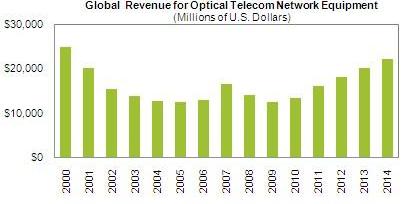 Data from iSuppli and Lightwave For much of the last ten years, the big markets for fiber like telecom in the US have been stagnant while overseas markets like China and India have been growing. In recent years, FTTH systems have been growing fast so the overall market has begun growing again. Interestingly, the current recession has affected the market for fiber very little, as system expansion for the Internet and wireless backhaul have grown unabated. Wireless Needs Fiber To Expand Cell phone systems have always used a lot of fiber to connect the towers into the telecom backbone and expansion of cellular services has led to adding more fiber to connect those towers. But have you noticed how the antennas on top of cell towers have multiplied recently? 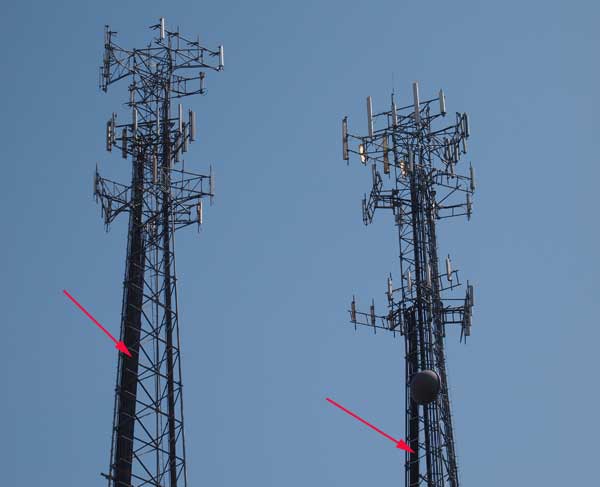 All those new antennas are needed to provide the bandwidth for smart phones and other portable devices for new services like video downloads. Many towers now have racks of giant coax cables going up to the antennas. The big coax cables are needed because of the bandwidth - and power - requirements of the antennas. These cables are expensive, heavy and cause the towers to have more problems in high winds. Plus, they are difficult to install. This is another application being replaced by optical fiber! One small fiber cable can replace all those coax cables and a separate power cable is used for the drivers on the antennas. We expect these applications to use mostly prefab cable assemblies since making terminations on top of the tower is difficult to say the least. But installers still need to be fiber-trained, as careful installation, cleaning and testing are still required. There are several new issues with multimode fibers which need addressing that the FOA is already actively involved with. These are new issues caused by new standards, applications and technology. These are issues we see needing attention that you should be aware of now. Bend insensitive (BI) fiber is made by adding complexity to the index profile of the fiber that reflects light back into the core. As far as we can tell, each manufacturer has a slightly different way of implementing it. At the current time, it is unknown whether BI multimode fiber is compatible to conventional multimode fiber or other manufacturer's BI fiber. Until we know more, we do not recommend mixing BI and conventional fiber nor mixing BI fibers from different manufacturers either in actual systems or in testing unless the manufacturer specifically OKs it (see Corning note below.) OFSTP-14 (see below) has been revised and has introduced a number of uncertainties. Although it allows OTDR testing instead of LSPM insertion loss testing, all the warnings about using OTDRs appropriately still apply. OTDRs are not appropriate for short cables nor do they test according to how cable plants are used, so the results may not be valid. The new OFSTP-14 also calls for a new mode power control called "Encircled Flux" (EF) that appears to not ready for real world use. Measuring EF is a tricky lab exercise and labs are having some trouble with correlation. Implementing EF is also tricky and users testing commercial devices are also getting mixed results. Bottom line: the new OFSTP-14 is not quite ready to use in the field. As a "standard," it is a recommendation, not a requirement, and anyone calling for it in a contract needs to be made aware of the pitfalls of the new version. FREE Webconference hosted by the TIA's Fiber Optics LAN Section! Bend, Bandwidth or Both? Making the right choice for the enterprise market. Presented by Ravi Yekula of Corning Optical Fiber. The Webconference is available on-demand at: http://www.brighttalk.com/webcast/23311/play. A copy of the slides are available as a PDF download from our Website in our Webconference Archives. If you are evaluating what fiber type to install in your enterprise network, don't miss this webinar. This webinar will cover:
 The Asia Communications and Photonics Conference and Exhibition (ACP) is Asia's premier conference and exhibition in the Pacific Rim for photonics technologies, including optical communications, biophotonics, displays, illumination and applications in energy. The event will take place 9-11 December 2010 in Shanghai, China at the Shanghai International Convention Center & Oriental Riverside Hotel. There is still time to plan your trip. Read More. New FOA Certification On Outside Plant Fiber Optics, Online Study Guide, Reference Textbook With the CFospT outside plant certification, the FOA focuses on OSP fiber optic network design, installation and maintentance. A CFospT certified tech must know the ways that fiber is used in the OSP, how it is installed, tested and maintained. While a CFOT might only have a basic knowlede of fusion splicing and OTDR testing, for example, a CFospT will be knowledgeable and skillful in those areas - and more. Reference materials for the new CFospT are the printed textbook, the FOA Reference Guide to Outside Plant Fiber Optics (right) as well as eBooks from Amazon for the Kindle or Apple for the iPad/iPod/iPhone and the OSP reference section of the FOA Online Reference Guide which now includes a self-study guide to the CFospT exam. More information on the FOA Outside Plant Fiber Optic Technician (CFospT) certification. Want to know more about OSP? There's OSP Magazine for that - and a trade show, OSPExpo, running this fall in San Antonio.
   We have created three new FOA books to be used in training for FOA certifications and as reference books for contractors, installers and end users of fiber optics. These books have full curriculum support, including free curriculum materials for teaching FOA certification courses. Because we are self-publishing these books using more modern "publish on demand" technology, they are easier to keep up to date, easier to buy and much, MUCH cheaper! All are now available in print and electronically in Kindle and Apple iBook versions. Details on the new book each of the new books are at the book pages linked to the photos above. FOA Online Fiber Optic Reference Guide New OSP Reference Section on the FOA Online Reference Guide website Joining our basic fiber optics and premises cabling sections on the FOA Reference Guide website is a new outside plant reference section that covers materials like that in our new textbook. The material is ready for use and will be followed shortly by a self-study guide. Both the OSP textbook and website are being prepared as references for the new FOA CFospT outside plant technician certification, due this fall. New, FOA Videos Now on  and a new reference guide page
on Polarity and a new reference guide page
on PolarityThe FOA Online Fiber Optic Reference Guide has become very popular - perhaps the most popular technical website ever, typically with over 30,000 users downloading about 1/4 million pages monthly! We continue updating materials regularly, keeping it as up to date as possible. Just this month, we added a page on "polarity" for fiber optic networks. Although it seems obvious that connecting transmitters to receivers is required, how it's accomplished can be confusing! We already updated the Premises Cabling sections in conjunction with publishing the FOA Premises Textbook and are now focused on outside plant applications (OSP) with a new OSP reference section. We've already added a new page on chromatic dispersion (CD) and polarization-mode dispersion (PMD). Find What You Want Using "Google Custom Search  There's
so much information on the FOA Tech
Topics and Online Fiber Optic Reference Guide
that even a well-organized Table of Contents isn't enough and when the
material is always changing, an index is impossible to maintain. So the
FOA is using the latest technology in search, Google Custom Search,
which will allow you to search just the
FOA Tech
Topics and Online Fiber Optic Reference Guide for
any topic you want to find more about. Try
it! There's
so much information on the FOA Tech
Topics and Online Fiber Optic Reference Guide
that even a well-organized Table of Contents isn't enough and when the
material is always changing, an index is impossible to maintain. So the
FOA is using the latest technology in search, Google Custom Search,
which will allow you to search just the
FOA Tech
Topics and Online Fiber Optic Reference Guide for
any topic you want to find more about. Try
it! Go to The FOA Online Fiber Optic Reference Guide. School News Featured School - New FOA Courses in UK BDI DataLynk, which offers fiber optic courses around the US in partnership with colleges, will offer FOA Sanctioned Fiber Optics Courses in the UK starting January 2011. Mr. John Tait has become the BDI Datalynk Instructor Partner and will be teaching all courses starting 26th January 2011. John has worked in the fibre optics industry for 35 years and has been involved in fibre optic cable manufacturing and distribution both in the United States and the UK. Over the last 25 years he has provided training in fibre optic technology to people in many countries around the World. John holds a Masters Degree in Physics from London. The FOA-BDI Datalynk course location is: West Kent College Brook Street, Tonbridge, Kent. TN9 2PW | Tel: 01732 358101 http://www.wkc.ac.uk/ CFOT - 24th January to 26th January, 2011 CFOS/T - 27th January to 28th January, 2011 CFOS/S - 31st January and 1 st of February, 2011 Please direct all questions regarding the course to: Mr. John Tait via email at: tait731@btinternet.com We are happy to welcome Mr. Tait on board and appreciate the opportunity to add West Kent to our training course list. Welcome New FOA-Approved School: 3CNET, Nigeria, #743 Find a listing of all the FOA-Approved schools here. It's Now A Lot Easier To Find A FOA-Approved Training Organization 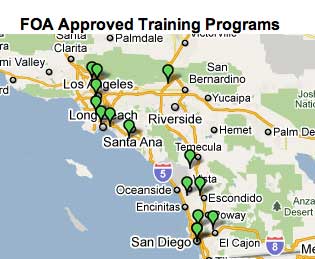 Most phone calls we get regarding finding a FOA-Approved training organization want to know two things: what school is closest to me or what school offers the certifications I need. That can be difficult, since the FOA has almost 200 training organizations we have approved worldwide! We've been looking at ways to make it easier, and we think we've got a good solution. In fact we have two solutions. First we have added a sortable table of all the FOA-Approved schools. You can also use our FOA Google Map Application to find FOA-Approved schools. Here are links to the sortable table of all the FOA-Approved schools and FOA Google Map. What Should A Fiber Optics or Cabling Tech Know and What Skills Do They Need? The FOA has been updating its lists of KSAs (Knowledge, Skills, Abilities) for fiber and cabling techs. The updated list is now on the website for your information and comments - as fiber and cabling KSAs evolve as new technologies develop. KSAs for fiber and cabling techs. Good Question! Tech Questions Worth Repeating Tech Hint: Did You Know You Have A Fiber Optic Tester In Your Pocket? Yes! The camera in your cell phone is sensitive to infrared light - lots more than your eye - and can detect light in an optical fiber or from a transmitter. Chris Hillyer,CFOT/CFOS/I, Master Instructor, Northern California Sound & Communication JATC sent us some photos showing how this works. See below. Communications over Power Lines Q: What do you think about transfer of data on existing electrical wiring systems? A: Powerline communications (PLC) have been promoted here in the US for a decade, first as a way to carry network/Internet signals throughout the house to avoid installing cable. The technology ran into problems with noise (both external RF and from noisy electrical devices including light dimmers and motors), limited distance and limited bandwidth. Of course, inside building connection has been taken over mostly by WiFi but Verizon for their fiber to the home program, FiOS, use mostly coax from CATV systems with a system called MOCA (http://www.mocalliance.org/). Now PLC is being promoted for networking appliances and HVAC systems. The success or failure of this market will depend on appliance and HVAC manufacturers accepting the concept. Buried Cable Depths Q: What is the proper depth to bury underground cables? A: We've researched this for our latest book on OSP fiber (http://www.thefoa.org/FOArgOSP.html) and can share with you our findings. The most widely used "rule of thumb" is bury fiber 3-4 feet (1-1.2m) deep, with a ton of exceptions. In suburban areas where cables are grouped and marked and backhoes are less likely to dig up cables, it's not uncommon to bury cables 18-24 inches (~0.5m) deep. In areas with "cable congestion," like Boston during the "big dig" cables were at all depths - many much deeper. In cold climates, freezing water in conduit can be an issue and cable manufacturers are capable of supplying special cables for these installations. About 15 years ago, we worked with a project to test fiber at the Scott-Amundsen base in Antarctica where fiber optic cables were run aerially, direct buried and run in conduit with no problems. Although I've been in MN in mid-winter and thought it was like Antarctica, I thing the real place is probably worse! Our answer, then, is shallower depths are OK as long as the cable is chosen appropriately for the installation. Link Lengths on Long MM Fiber Cable Plants Q: I’m in the process of proposing some LAN switches for a client which involves selecting some 10G SFP modules based on the type of fiber presently on site. For instance one of their sites has OM3 MMF 50/125 fiber installed and I need to know the cable distance limitations. I have this document but I’m not sure where the OM3 MMF 50/125 fibre sits within it. I can’t make sense of the Modal Bandwidth spec? I assume because it’s OM3 it has a cable distance of 300m? How do I work out the Modal Bandwidth? Is this specific to the fiber or the module? A: Modal bandwidth is one of the standard specifications for multimode fiber, tested by the manufacturer. It is generally not tested in the field today. Each network specifies a maximum length based on the bandwidth of the fiber that is 100% certain to work with the network equipment. This is a webpage that defines the specifications for fiber types and references the standard designations: http://www.thefoa.org/tech/OM.html This webpage has a listing of most types of networks to 100 GB/s and their specified cabling distances with different types of fibers: http://www.thefoa.org/tech/Linkspec.htm Mixing 50/135 and 62.5/125 Fibers Q: I work at a college campus. I have been asked about using 50/125 micron pigtails and fusion splicing them onto the existing 62.5/125 fiber to create a 10GB fiber back bone. Will this work? A: I don't think that's going to work. The Ethernet committee has published specs on all their networks (see http://www.thefoa.org/tech/Linkspec.htm) and at 10G 62.5 fiber is only good for about 33m. One does not know the quality of older fibers and many had serious bandwidth issues with VCSEL sources. Furthermore, mixing 50 and 62.5 fiber can lead to up to 1.6 dB loss when going from 62.5 to 50 micron, (http://www.thefoa.org/tech/fib62-50.htm) using up most of your loss budget ("Linkspec" link above). Even fusion splicing old 62.5 fiber can cause bandwidth issues! If the goal is 10GbE, I'd recommend a new cabling system based on OM3/OM4 fiber. Furthermore, I'd use LC connectors to prevent mismatched fiber connections! This is a webpage that defines the specifications for fiber types and references the standard designations: http://www.thefoa.org/tech/OM.html Using OM3-OM4 Fiber Q: We're currently in the process of linking up 2 locations through a fiber connection. The network has a speed of 100 Mbps. The switches at both ends are <company> switches, and the optic ports are SFPs plugged into these switches. <company> states that their switches work with OM1, OM2 and OM3 fibers. As a side note, they mention that they do not use SFPs with VSCEL technology at this time. My question is, Even though the SFPs do not support VSCEL, can we use an OM3 type of cable to link up the 2 locations? A:Any multimode fiber will work with LEDs or VCSELs. The design of laser-optimized fibers (OM3 and now OM4 - see http://www.thefoa.org/tech/ref/basic/fiber.html) is simply to refine the graded-index profile to reduce modal dispersion, necessary for using VCSELs at 1 Gb/s and above. LEDs work perfectly well in these fibers. LEDs are not used in faster networks than 100-200 MB/s simply because LEDs are not fast enough - the devices themselves have limited bandwidth, and they suffer badly from chromatic dispersion (also in that link above). OM3 fiber is more costly than OM2 (and about the same as OM1), but if the intention is to ever upgrade to higher speeds, it's a good investment. Some source manufacturers have recommended customers only use VCSELs as they are so cheap! Telco Fiber Types Q: A customer called for a SM fiber for a OC-48 d-marc extension from one floor to another in a building. So that is what we installed. I was taught that visible red laser light uses single mode fiber for high speed xfer. However, the OC-48 light seems to be invisible which I think is infrared. Should we have used MM fiber? Do you know the light frequency of an OC-48 circuit? A: All telco transmission such as an OC-48 link will use singlemode fiber with a 1310 nm or 1550 nm laser source which is quite invisible to the human eye. The only use for red lasers and singlemode fiber is for tracing fibers to ensure continuity or proper connections. Red LEDs are used with plastic fiber for short links like consumer audio - their only use for links. Who taught you that red lasers use SM fiber for high speed transmission? I want to chastise them! Life Expectancy of Fiber Optic Cable Q: I'm trying to find information relating to the expected working life of fibre cables in different applications, specifically in underground applications within conduits and aerial on existing utility poles. A: We have talked to cable manufacturers who say cables are designed for approximately a 40 year lifetime (a number that sometimes shows up in bid packages - see this package .) The glass fiber is good for millennia, of course, as long as the coatings remain hermetic, but the plastics used in the cable will have a shorter lifetime. This lifetime only applies to a cable, which can be compromised by damage to the cable during installation (cuts in the jacket, pulled with excess tension, kinked by bending around a smaller radius that specified for the cable, etc.) In addition, you have the lifetime of splices and terminations and any other hardware involved. Where reliability is a concern, fusion splices should be used and splice closures carefully sealed and perhaps even purged and pressurized with dry nitrogen. The biggest cause of failure is damage - from "backhoe fade" -digging up buried underground cables - or "target practice" on aerial cables (a problem you may not have like we do here in the USA!) One major cable incident happens each day in the USA on the average! We suggest you also consult with cable manufacturers. Cable Twists Q; I work for the U.S. Navy and am trying to find information on fiber optic cable twisting when loaded & unloaded from a drum or spool. Although we are winding the cable on & off the drum and not from the end of the spool such that we'd impart a twist, we are still seeing a twisting in the cable. It does see a load (~200 lbs) but it's always directly through the cable length. We're trying to understand how the twist happens, how much it might grow and what are the potential changes in physical properties to the cable because of the twist. I think I've been able to loosely explain what our issue is and hope that you might be able to point me in a direction that I could get some more detailed information (reports, etc.). A: All cables are manufactured with some twist in the components. The fibers and strength members are helically wound around the central strength member in OSP cables. Many cables have a counter-helical twist that revolves clockwise for a short period then counter-clockwise for an equal period to reduce the tendency of the cable to untwist under load. The fibers are isolated from the strength members in tight buffer cables, usually inside them, or in buffer tubes where they are loosely enclosed to allow the cable to withstand high tension loads. Cables are designed to be pulled by the strength members and those are isolated from the fibers to prevent damage. Some cable designed to be left under tension after installation like ADSS (all dielectric self-supporting aerial cable) is designed to have the jacket under tension without causing stress on the fibers. If you have a cable being loaded by pulling on the jacket and the cable jacket is not designed to be used for pulling, it will stretch and the internal structure will untwist because of its helical wound structure. My question is how are you pulling this cable? And is it designed to be pulled this way. Most cables are to be pulled only by the strength members, not the jacket, may untwist when pulled by the jacket. Pulling Fiber Cable Q: We have to install one fiber optical cable parallel a huge water tube for two distances (2.7 Km and 3.3 Km) and we want to know if it is better to install the cable using junction boxes or just install the tube and use a pressure gas puller for each length. A: The FOA does have information on installation in several places: User's Guide web page: http://www.thefoa.org/user/index.html Tech Bulletin on installation: http://www.thefoa.org/tech/index.html#anchor25731930 Online Reference Guide, Installation section: http://www.thefoa.org/tech/ref/contents.html#Install Outside plant installation web page: http://www.thefoa.org/tech/ref/OSP/install.html For the installation you describe, the issue is how long a distance can the cable be pulled. That is determined by the friction of the cable in the conduit and the length. A vendor, American Polywater, has a calculator software that can assist you in determining the length you can pull with proper lubrication: http://www.polywater.com/ and the pulling calculator: http://www.polywater.com/pullplan.html and http://www.polywater.com/calculators.asp You should also always consult with the cable manufacturer. dB - What does it mean, exactly? Q: In FRG to Fiber Optics Pg 51 it states "For example, the loss of ............only 1 dB/km. That means at 850nm, half the light is lost in 1km, while only 20% is lost at 1300nm" Does that mean half of the transmitted power is lost when transmiiting at 850nm? How do you derive the 20%? A: 3 dB is a ratio of 50% in power, so a loss of 3 dB means the power is lower by 50% at the end of 1 km of fiber. Likewise, it's down another 50% to 25% of the starting amount at the end of the second km, and so on. At 1300 nm, the loss is only 1 dB or about 20%, so there is 80% of the initial power level at 1 km, 64% at the end of the second km (0.8 x 0.8 = 0.64) and so on. You can calculate dB from power by using dB = 10 log (power ratio) The FOA Online Reference Guide has a page on measuring optical power (http://www.thefoa.org/tech/ref/testing/test/power.html) that has an Excel Spreadsheet that calculates dB/power ratio and dBm/milliwatts) so you can calculate the actual values. Reference Textbook Q: There is a 4th edition of the Fiber Optic Technicians Manual published recently. Isn't that a FOA book? Why is it not listed as a reference for the FOA certifications? A: The FOA wrote the FOTM in 1997 and has used it as the reference book for FO training until this year. When the price of the FOTM 3rd edition nearly reached $100, the FOA decided it was too expensive for our own training, although we had just sent the publisher the updates for the 4th edition. We decided to created our own references and self-publish, cutting out the high costs of the publisher. Now we have our own books at a fraction of the previous costs, even cheaper as eBooks on the Kindle or iPad, plus a complete website with online study guides. The FOA curriculum materials and exams were not updated for FOTM 4th ed. and references to FOTM 3rd ed will be gone at the end of the year. Loss Budgets Q: I have a question about loss budgets. Should you count the last connector, because you only get a loss if you mate the pair. If the link plugs directly into a machine then are the last connectors counted? A: This question arises occasionally because the copper equivalents offer two options, with and without connections on the end. However, fiber convention is only to consider an installed fiber optic cable as a permanent link, This is because 1) it is necessary to connect the fiber in the link being tested with a source with attached launch cables to be able to establish test conditions and a meter with attached receive cable to test the connector on the receive end. 2) The permanent link will be used with patchcords which means the reference cables emulate real usage including the loss of the end connectors. 3) Systems manufacturers and standards committees (e.g. Ethernet) define their loss budgets based on a test which includes the loss of the connectors on each end, with usage including patchcords that provide transmitter and receiver coupling. 4) You never test by just connecting a source and meter, with the rare exception of connectors that are not designed for mating, like some POF connectors, where you use a cable substitution test. Even if we have a cable that is used to connect to equipment directly without patchcords, the convention to include the loss of end connectors is followed, otherwise there is no way to verify the quality of those connectors. We cover this specifically in the book, eg on the top of page 132 of the FOA Reference Guide to Fiber Optics, on the web pages and in all the examples. Fiber Cleaning This is a topic we keep reminding everybody about, and here is why: From a contrator in the Middle East: Here some samples of the connectors for SM fiber already installed in the system we were testing. 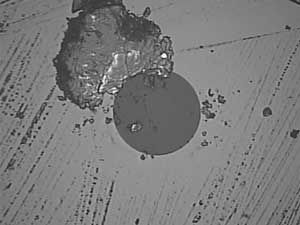 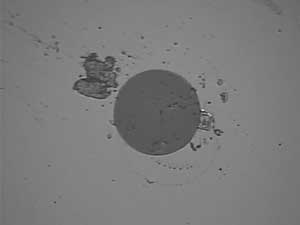 As you can see, the dirt is large compared to the size of the fiber (dark gray), and the core (not visible here) is only 9/125 of the overall diameter of the fiber! See Product News below for links to vendors of fiber cleaning products. Measurement Uncertainty: Everyone testing fiber optics should understand that every measurement has some uncertainty - whether you are measuring loss, length, wavelength, power, etc. Knowing that uncertainty is very important to interpreting the measurement. It's worthwhile to read and understand the issue of measurement accuracy covered in this page of the FOA Online Fiber Optic Reference Guide. Worth Reading: JDSU Application Note On "Qualifying FTTH Network before Equipment Installation" Another great paper from JDSU covering FTTH PON networks is available for downloading. It gives an overview of FTTH architecture, cleaning connectors then testing the cable plant with OTDRs and OLTSs. This paper will help you understand why OTDRs can be confusing on PONs! Best Practices For Wireless Backhaul Network Upgrades Joan Engebretson, Contributing Editor of Connected Planet has written a very good overview of how fiber is essential to the operation of cellular wireless systems. Everybody probably knows that fiber is used to connect towers into the telecom network - they call it backhaul - but her article also covers the new appliations to replace bulky, heavy, lossy coax up the tower to the antennas. http://connectedplanetonline.com/images/CP_ADC2_WhitePaper.pdf. Fiber Optic Safety Poster We've had numerous requests to reprint our guidelines on safety when working with fiber optics, so we have created a "Safety Poster" for you to print and post in your classroom, worksite, etc. We suggest giving a copy to every student and installer. Corning now offers videos on  . Lots of interesting videos, some technical, some sales, but all good information. . Lots of interesting videos, some technical, some sales, but all good information.US Conec's videos on cleaning fibers - show's the results of proper cleaning. Webinars of Interest Broadcast Engineering Magazine - Fiber Optic Testing FOA President Jim Hayes presents an overview of fiber optic testing for all applications. Available on Demand. Sign up here. Multimode Fiber Trends from TIA's Fiber Optics LAN Section Ryan Chappell, Draka Communications, looks at the evolution of multimode fiber, examines its current usage and shares predictionson its future Available on-demand at: http://www.brighttalk.com/webcast/7182/play OSP Magazine Webinars OSP Magazine (OSP as in outside plant telco) is now offering a number of interesting webinars that cover fiber topics, including network design and specialized components. http://www.ospmag.com/events/web/ Multimode Fiber Characterization Launch Condition Considerations - new ap note from JDSU JDSU Reference Guide to Fiber Optic Testing – Volume 2 Published  The second volume of the JDSU series on fiber optic testing has been published. Volume 1 focused on Basic Fiber testing and Volume 2 is geared toward fiber optic installers, project managers, telecom technicians and engineers who need to understand fiber networks. Volume 2 also covers Chromatic Dispersion, Polarization Mode Dispersion, Attenuation Profile and Fiber Link and Network Characterization. A 3rd volume, a glossary of fiber optic terms, is also available for download. This is a "MUST HAVE" for all fiber optic techs. Download your free copies here. We used this book as one of our references in creating a new page in the FOA Online Reference Guide on chromatic dispersion (CD) and polarization-mode dispersion (PMD). Careers in Fiber Optics: Brian Smith. A 1998 book on fiber optic jobs is a bit dated, but a free overview is on Google Books and worth a look at it online. Dirt! As much as 70% of the problems associated with deploying fiber to the home result from something as simple as dirty connectors according to JDSU. Telephony Online. US Conec's videos on cleaning fibers - show's the results of proper cleaning. Good Technical Websites American Polywater (http://www.polywater.com/) has one of the best technical website for cable installers. Here is a rundown on some new material on their site. Cable Installation using "Push" or "Push/Pull" Polywater's new Pull-Planner™ 3000 Software allows a "pushing force" variable in pulling tension calculations. Read a White Paper that quantifies the push contribution and compares calculation results to field experience. -- http://www.polywater.com/pushing.pdf Pulling Cable Through Water? Read a Product Spotlight on Polywater® + Silicone™, Polywater's new generation underground lubricant. Continued reduction of friction when pulling through water is only one of the unique features of this lubricant. -- http://www.polywater.com/NNNBSL.pdf Check out their website, especially “Videos,” “Engineer’s Corner” and “Calculators.” http://www.polywater.com/NNNBSL.pdf  " Heard on the Street" is a monthly online newsletter from Frank Bisbee of Communications Planning Corporation that covers the telecommunications and cabling businesses. Each month includes news from manufacturers, trade associations and professional societies like the FOA. You can read the current issue and back issues online.  JDSU has announced the See the Light webinar series, a four-part program designed for anyone involved in the installation, maintenance, and repair of fiber optic systems. It begins with fiber inspection and cleaning and then covers the basics of fiber testing. The webinar series then continues with the more advanced optical time-domain reflectometer (OTDR) and fiber local area network (LAN) testing challenges. More information on the series. IGI is offering a series of webinars on topics of interest to those in the communications industry. You can join them live ir download from the archives. IGI WEBINAR ARCHIVES UP AND RUNNING - VISIT TELECOMBRIEFINGS.COM TO DOWNLOAD! IGI, a major market research and technology reporting company (the "Active Optical Cables" below) is offering a a free one year subscription to one of our fiber optics newsletters to FOA members. All they have to do is to send IGI an e-mail stating which newsletter they would like to get. See http://www.igigroup.com/nl.html for a listing of IGI Newsletters. A Fiber Optic Tester In Your Pocket? Yes! The camera in your cell phone is sensitive to infrared light - lots more than your eye - and can detect light in an optical fiber or from a transmitter. Chris Hillyer,CFOT/CFOS/I, Master Instructor, Northern California Sound & Communication JATC sent us some photos showing how this works and the following description. 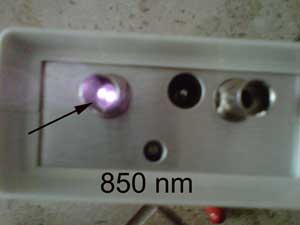 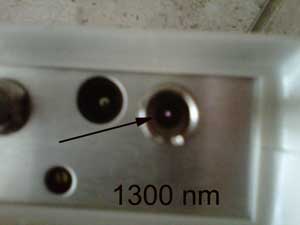 "Your cell phone camera's image sensor can read IR light. It uses this technology to help take pictures at night. In the advanced audio and CCTV field they have been using the smart phone camera to trouble shoot problems in IR communications. The human eye cannot see the IR light emitted by let’s say a remote control. Well up until now we would always say that the remote is out of batteries, or either the IR transmitter or IR receiver was not working properly. Now we can use your smart phone camera to see the IR light emitted by the IR transmitter. All you have to do is turn on your camera function on your smart phone and hold it up the remote control and push any button. The cameras screen will show the IR light. Now back to Fiber Optics. If you follow the same principals of the last paragraph, let’s say you wanted to check if a fiber port was energized. You can either use the card that is supposed to show you in a few seconds that the port was hot. Or you could plug in your meter, in this case it takes some time to find the card or if you don’t have your meter handy. Just pull out your smart phone turn on the camera and hold it over the port. If it is hot you will see a bluish white dot in the fiber bulk head (see attached pictures)." We tried this ourselves and found our camera phone very sensitive at 850 nm but as expected less so at 1300 nm, like all semiconductor detectors. Our phone could still see 1300 nm sources at around -20 dBm, making it very useful even for LED sources, and of course, perfect for lasers. OFSTP-14 Update OFSTP-14 is the TIA standard for testing installed multimode fiber optic cable plants which has been around more than 20 years and is the one TIA standard probably most familiar to contractors and installers. The TIA has adopted IEC 61280-4-1 as the replacement of OFSTP-14. Most of the two documents is the same, with some important exceptions.
We are creating a web page to explain the differences and will give you a link shortly. In the meantime, continue testing as usual. The FOA reference website is now online. New sections have been added on Outside Plant Fiber Optics, fusion splicing and mechanical splicing. Check out the current Table of Contents. This month, we added a page on "polarity" for fiber optic networks.
Corning ClearCurve® Bend-Insensitive (BI) Optical Fiber Compatible With Other Multimode Fiber Types October 26, 2010 Re: Compatibility of Corning ClearCurve® bend-insensitive multimode optical fiber Corning ClearCurve® multimode optical fiber combines the high bandwidth performance of laser optimized fiber types, e.g. Corning InfiniCor® SXi (OM2), InfiniCor®SX+ (OM3) and InfiniCor® eSX+ (OM4) fibers, with advanced macrobending performance. ClearCurve® multimode is specifically designed for Enterprise networking applications such as LAN (local area network), SAN (storage area network), campus networks and Data Centres. All Corning ClearCurve multimode fibers are able to support transmission speeds of 10/100 Mb/s through to 10Gb/s and are ready for next generation speeds of up to 16/40/100 Gb/s. • ClearCurve OM2, OM3 and OM4 multimode fibers are compliant and fully backwards compatible with all relevant industry standards;
multimode installed base
• ClearCurve multimode fiber may be spliced or connectorized to conventional 50/125 fiber types with commercially available equipment and established practices and methods; no special tools or procedures are required. Testing has been done with Corning fibers and various competitive standard and bend insensitive fibers and no issues were observed. Corning has stated that all their MM fiber will be BI fiber and has created an app note on how to implement the TIA-spec mandrel wrap with this fiber. Here is the complete information reported in the FOA April Newsletter. AFL Launches Fiber Security™ Perimeter Intrusion Detection System New system incorporates fiber optic sensing cable and vibration sensor unit 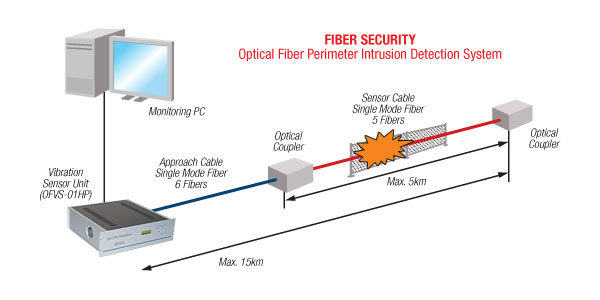 AFL announces the release of its optical fiber perimeter intrusion detection system, Fiber Security. While new to the US market, this system has been deployed more than 40 times in Japan and Canada by AFL's parent company, Fujikura Ltd. Fiber Security utilizes a fence-mounted fiber optic cable coupled to a sensing unit that analyzes the magnitude and pattern of vibrations at the fence. The sensing unit's unique algorithm is capable of discerning high and low level vibrations and filtering out vibrations not associated with intrusions. Up to 100 individual zones can be set up using the software, and the individual zones can have different levels of sensitivity as needed. Detection accuracy is +/- 2% over the entire sensing length of the perimeter, up to 3.1 miles in length while operating up to 6.2 miles from the sensing unit. No power is required in the field with only standard 110V power necessary at the sensing unit and PC. A user-friendly graphical interface depicts the property and the perimeter giving visual representation of where an intrusion is detected. AFL's Fiber Security is highly successful at detecting multiple intrusion events such as climbing, cutting, or lifting a fence. Environmental noise such as traffic, trains, or planes, and wind and rain are actively filtered out by the algorithm to reduce false positives while maintaining sensitivity. The system can be integrated with video systems and other technologies such as passive IR sensors via Ethernet, dry contactors, or RS232 connections. Fiber Security can send remote alerts via e-mail for facilities that do not have full time personnel on site. Highly dependable laser diodes coupled with a completely passive optical sensor translate to low maintenance costs over long periods of operation. With the ability to function as a standalone system or as part of an integrated security solution, AFL's Fiber Security is now available to meet your perimeter intrusion detection needs. For additional information, visit www.AFLtele.com/go/FiberSecurity. Benchtop Connector Cleaner 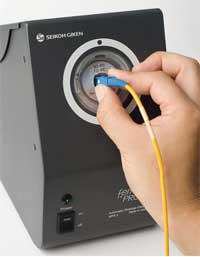 FerrulePro™ is the world’s first fully automated benchtop fiber connector cleaner for laboratory and cable production environments. It automates the final cleaning of all types of terminated fiber products, a critical task where performance once depended largely on the production line worker’s skill. Fiber connectors can be cleaned in 3 seconds cycle - eliminating the need for re-cleaning after post production inspection. More. End-Of Summer Sale on FO Toolkits at TTTP Save 25-40% off Advanced Fiber Solutions fiber optic installation toolboxes with test equipment. Go here. New AFL Cleaver Does Regular and Angle Cleaves Both cleavers incorporate an easily replaceable blade and cleave 250µm and 900µm fibers. They are easy to use, simple to adjust and extremely consistent. More details. Draka Expands Bend-Insensitive Fiber Line A large number of Draka fibers are available with BendBright-Elite fiber. In North America, BendBright-Elite is available in premises and outside plant cables. Draka introduced the BendBright family of bend insensitive fibers in 2002 and has since expanded the product family to four versions of bend insensitive fiber, spanning both singlemode and multimode types:
But it means changes in the way you test with it! Corning announced that effective April 1, 2010, ClearCurve® multimode optical fiber will become its standard 50-micron multimode fiber product offering. "ClearCurve multimode fiber is the world’s first laser-optimized, high-bandwidth, multimode fiber to withstand tight bends at 7.5 mm radius with substantially less signal loss than traditional multimode fibers. ClearCurve multimode optical fiber was first introduced by Corning in Jan. 2009 and has been validated through broad customer acceptance of the product. Traditionally, when an optical cable experiences tight bends, some of the light can escape from the fiber core and part of the signal can be lost. Corning ClearCurve multimode fiber is designed to keep the light in the fiber core, even under tight bends, and better maintain the integrity of the optical fiber signal. “Corning’s 50-micron multimode fiber customers will now benefit from superior bend performance. This will result in faster and more efficient optical cable routing and installation, and significantly higher spare operating margin, at no additional cost,” said Martin J. Curran, senior vice president and general manager, Corning Optical Fiber. Corning ClearCurve multimode fiber meets or exceeds the OM2, OM3 and OM4 industry standards for high-bandwidth, laser-optimized multimode fiber. Corning will demonstrate the performance of ClearCurve multimode optical fiber from March 23-25, 2010, at OFC/NFOEC in San Diego. Detailed product specifications are available at www.corning.com/clearcurve." When You Test... Most standards call for a "mandrel wrap" mode conditioner on your launch cable. The Corning announcement made us wonder what happens with this bend-insensitive fiber if you wrap it around a standard mandrel - it should not act the same as regular 50/125 fiber. We contacted our friend the Marketing Manager for the product at Corning and he confirmed our suspicions. The difference in the bend sensitivity of the fiber requires a much smaller mandrel, only 6 mm in diameter, to have the same effect. This is detailed in Corning Application Engineering Note "Multimode Fiber Considerations for Test Jumpers, AEN 131, Revision 2" available from Corning. Add OCC to the list of cable manufacturers offering "bend-tolerant" cables. Draka too.(Lightwave) AFL Introduces 3 new Noyes OTDRs(Lightwave).
They're still being used for high power laser delivery - up to 80-100W! Seikoh Giken has even introduced some new ones. Used Test Equipment – Buy or Sell http://www.testequipmentconnection.com/ Have you read the FOA Tech Topics on Cleaning? More links on cleaning: Cleantex Alco Pads FTTH or FTTC? That's the competition between Verizon FiOS and and AT&T U-Verse. The graph below, courtesy of IGI from their ecent report, “FiOS vs. U-verse; Architecture, Marketing, and Technical Considerations,” shows FiOS ahead but the gap narrowing as Verizon winds down their extremely aggressive FTTH program. 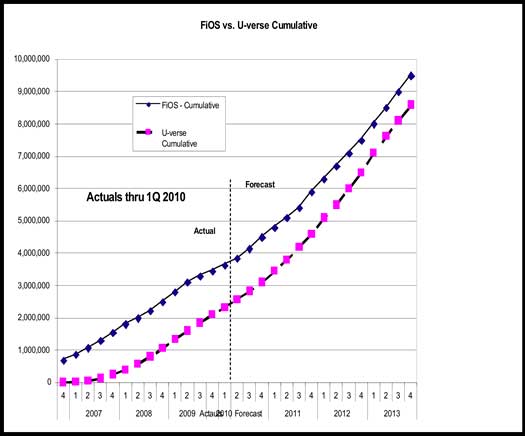 Woodstock Goes FTTH - Woodstock Telephone Company in Minnesota, that is. Delivering up to 75 Mb/s over a 450 square mile service area. (TellLabs) Residents of Ashby de la Launde, a small village in Lincolnshire, UK, will soon be able to install 100-Mbps fiber-optic broadband into their homes via the FTTH network. Lightwave. Nearly 60 homes and three businesses have started on-site digging to connect to the FTTH network to be installed around the village. The project involves the community working together to establish a privately funded network. New Report : FTTH connections continue to grow in North America You can download and read the entire report from the FTTH council website. http://www.ftthcouncil.org/sites/default/files/RVA.FTTH_.Apr10.040712Final.pdf Testing FTTH JDSU shows how to test a PON with an OTDR: http://www.jdsu.com/other-literature/PON-OTDR_fop_an_ae.pdf US FTTH Connections Continue To Grow 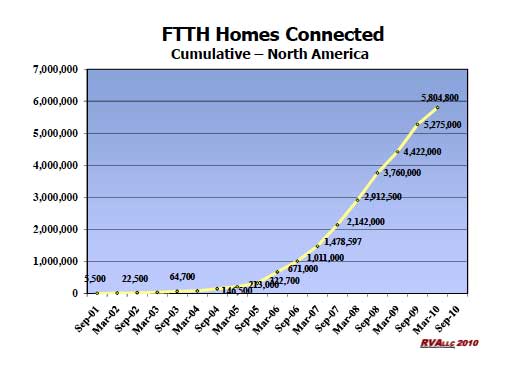 According to a just released FTTH Council Report prepared by RVA, FTTH connections continue to grow in North America - 99% of which are in the US, but growth seems to be slowing, probably a consequence of the current economy. Much of the FTTH deployment in the US has been due to Verizon's $23 billion investment in FTTH, but the report noted that FTTH is now being deployed by more than 750 service providers across North America. Most of these service providers are small, independent telephone companies that are replacing their copper lines with end-to-end fiber to ensure their future competitiveness as broadband providers. Of the service providers not yet offering FTTH, a majority say they are likely to soon. You can download and read the entire report from the FTTH council website. http://www.ftthcouncil.org/sites/default/files/RVA.FTTH_.Apr10.040712Final.pdf David Chaffee's FTTH Prism Newsletter is Online (archives are at bottom of the linked page)
|
What Is The FOA? Hear FOA President Jim Hayes tell the FOA Story in a 2-part interview by Sound & Video Contractor Contributing Editor Bennett Liles. It tells about the FOA history, goals and achievements. Part 1: http://svconline.com/podcasts/audio/fiber_optic_association_part1/index.html. Part 2 http://svconline.com/podcasts/audio/inside-fiber-optic-association2-0924/index.html. |
|
Digging Safely (Read the FOA Tech Topic) There is a new toll-free "call before you dig" number: 811 See www.call811.com for more information National Fiber Optic Protection Summit: By the "811" group. March, 2008 in Vegas.
|
|
|
New FOA Jobs Website We get many questions from CFOTs, students at FOA-Approved schools and others contemplating getting into the fiber optic business regarding jobs in fiber optics - and how to find them - so we’ve created a new web page to share some information we've gathered about jobs in our industry. The information is designed to help you understand what jobs are available in fiber optics, how to find them and apply for them. While the overall economy is pretty bad - you've probably heard that there are 5 times as many people unemployed in the US as there are jobs available, telecom is a bright spot - broadband is a major focus of stimulus spending in the US and countries around the world are building fiber networks as fast as possible. Even wireless companies have to build fiber for their backhaul. Cities are installing fiber linked surveillance cameras and smart traffic lights. Fiber is the link making Smart Grid possible. Companies like Allied Fiber are building large private networks. Telecom is one of the fastest growing businesses worldwide. If you are looking for a job in fiber optics, here is the FOA's guide to jobs. The FOA has created a group on A list of 10 ways to get your resume noticed from Marketplace on NPR Jobs Created As Part of Stimulus-Funded Projects The federal government is spending 7.2 billion dollars on the Broadband Technology Opportunities Program. This money is working it's way into the economy and hopefully will provide jobs. You can track recovery dollars and look for job opportunities on this website: www.recovery.gov Go to "opportinities" link then "jobs". You will see a section “find recovery jobs” – enter “fiber optic jobs California” or wherever you are and review what comes up. Outside Plant Designer to join a team in Calgary and Fort McMurray, Canada. (10/28/10) In this highly varied and technical role, you will design the implementation of network Infrastructure projects. You will be working with fibre and copper outside plant cabling and wireless systems. More specifically, your responsibilities will include: • Coordinating, consulting, and providing support on all voice and data cable plant jobs and projects; • Providing technical solutions to support business needs and providing troubleshooting on technical problems; • Coordinating the requirements for and delivery of Redlines, As-Built Drawings and work packages; • Working with drafting personnel to produce and maintain drawings depicting splicing, terminating, and patching information, circuit assignments, and floor plans wall layouts, equipment cabinets, tray layouts, other equipment etc. We are looking for a Journeyman Communication Technician who has substantial heavy industrial experience and is actively involved in network infrastructure design. Ideally you are a Registered Communications Distribution Designer (RCDD) with outside plant specialization. We are looking for individuals who have extensive field installation experience. Having experience with cable designs for large heavy industrial plant sites and large campus environments will ensure your success in this role. We are seeking applicants who have experience with aerial communications cabling design and splicing of fibre in an outside plant environment. About the Benefits In reward for your hard work and dedication, you will receive a highly competitive remuneration package depending on qualifications and experience. Our client understands employing the right people is vital to their ongoing success; therefore they offer them a wide range of excellent benefits including: • Cell phone for work purposes; • Comprehensive benefits package including medical, dental, and vision plan; • Two weeks minimum vacation; • Relocation assistance may be provided. Please Apply Online to the location of your choice: Fort McMurray, Alberta – http://www.applyfirst.ca/job19812 Calgary, Alberta – http://www.applyfirst.ca/job20899 Fiber Optic Engineer – Research and creative new product development wisdom (10/12/2010) Do you just love to peal back the onion of a fiber optic product and find out what really makes it work and are challenged to make it work better? Does your interest in fiber optics go to digging into the physics of optical communications? Are you excited about finding ways to make high speed data transport optical cable better? When it comes to the next generation of premise wire for data centers do you have the wisdom to help create the fiber systems that will become industry standards? Then this engineering research opportunity will be a utopia for your career in creative engineering design and development within a research lab where you can excel. We’re looking for an engineer who is turned-on by researching, designing, and developing passive optical communication products that are ahead of the curve in anticipating customers’ requirements in high data rate fiber optic communication systems including cables, connectors, panels, cords, and other infrastructure products for critical communications networks. The goal of this engineer will be to create new fiber optic products with superior reliability, performance, and scalability. The top candidate for this responsibility will have a history of creative R&D with multi or single mode fiber infrastructure products and have demonstrated a career of product development knowledge that has led to production sensitivities required in lean manufacturing. This position focuses on strategic and tactical design engineering leadership and NPD for fiber optic components that will complement the company’s expansive telecommunication network product lines. By developing its offerings ahead of the curve and anticipating customers’ requirements in high data rate fiber optic communication systems, this Chicagoland company will continue its expansion as a world-class technology leader. The person in this position will join this half-billion dollar company’s “go-to” research team for NPD and will interact with cross-functional groups that will include engineering, manufacturing, marketing, and sales. Some challenges will include: 1. Lead the research efforts of advanced fiber optic products from concept through the proof-of-principle, explore and research emerging applications/ technologies that enable new product opportunities, and evaluate performances of optical communication systems, interconnect technologies, and new emerging optical technologies – some into the GHz range. 2. Using experimental research design, build, and troubleshoot prototypes/concept models using optical principles and test methods that will validate theories and models. 3. Perform measurements and benchmark analysis on fiber optic components, prototypes and existing products to determine future product design requirements. 4. Develop new optical test methods for prototype, component or product evaluations. Experience being sought: 1. NPD engineering background – in fiber optic infrastructure which may include: communication systems, components including lasers, detectors, transceivers, and optical cable and connectors, assemblies, and adapters. 2. Experience working with lean manufacturing environments and methods. 3. Innovation career track record of providing creative solutions to complex problems. 4. College Degree in related engineering sciences which may include: Physics, Optical Science, Optoelectronics, Photonics. If you think you have the skills to join this company’s R&D research lab team for new fiber products and have the wisdom for advancement in NPD, call me. Challenge your career, and become an industry creative leader for fiber optic communication. Or -- if you know someone whose career might be ready for this level of enhancement, please feel comfortable passing this information to you network. Jack Bourque President 860-738-5035 ex: 23 www.WirelessCareers.com Infrastructure Installation Technician (8/2010) Perform installation, termination and assist in signal loss testing of Fiber Optic SM and MM, Categories 3, 5 and 6, RG6 and RG11 cabling to industry standards and NSA specifications. Have working knowledge of both Single Mode and Multi Mode MTRJ, FC, LC, SC and ST fiber connections, shielded twisted pair copper (STP), and Un-shielded twisted pair copper (UTP) RJ-45 connections, RG6, RG11 connectors and wire wrap connections. Experience with and capable of installation of metallic and plastic conduit _” up to 2”, communications racks, cable tray, and grounding with supervision. Will be required to assist in the installation, removal of network devices in communications racks including switches, routers, fiber shelves, and cryptographic equipment, etc. Safe operations and use of hand and power tools. Must be capable of lifting 65 lbs. Perform end user equipment installation in an office environment to include multiple CPU and monitor interconnection using analog and digital switching devices, printers, plotters, faxes, analog, digital and IP phones, digital senders, etc. with minimal supervision. BS degree required or 3 additional years of experience. 1-3 Years of experience. Fiber Optic (CFOT) certification preferred. Experience working with the Military is a plus. This position requires a TS/SCI Security Clearance. Travel required. An Equal Opportunity/Affirmative Action Employer. Michael Bagford Technical Recruiter Scientific Research Corporation 1101 Remount Road, Suite 500 North Charleston, SC 29406 803-548-5811 mbagford@scires.com www.scires.com Manager System Test Verification: Reporting to the VP of Engineering - 8/2010 http://executive-advantage.com/Zhone_MSTV The ideal Manager, Systems Test Verification candidate must possess +8 years of complex hands on telecommunications Data/IP systems industry experience within the telecommunications capital equipment industry to include +5 years direct system test engineering management experience. This individual must possess a working knowledge of TDM networks and practical experience in deploying triple play services (data, video, voice) and includes how to troubleshoot fiber related issues as well as how to use tools for testing data, voice, and video services in a lab environment. As an engineer possessing strong engineering skills, this individual must be a domain expert in GPON with associated expertise in OMCI technologies and SNMP PON Management protocols. This individual is currently in a Systems Test Verification like role within the telecommunications Data/IP carrier access capital equipment industry. Also open to candidates possessing large Tier-1 Telco Provider Lab Trial experience. Michael A. Rothstein Managing Principal Executive Advantage Group Direct: 503-372-9084 mrothstein@executive-advantage.com Executive-Advantage.com Fiber/Communications Field Technician (7/2010) Fast paced communications cabling company in Glendale needs an individual with experience in the field of fiber optics installation and testing. Candidates must have experience in working with OTDR's and Fluke DTX testers and must know fusion splicing. Need good communication, leadership and customer service skills. Please call our human resources department at 818-241-6009 x 219 or email resumes to hr@pinnacleinc.com Pinnacle Networking Services Do listings in the FOA Newsletter Work? Here's feedback: "We did great! We have over 15 interviews next week." Thanks, David Swales, Jr. |
|
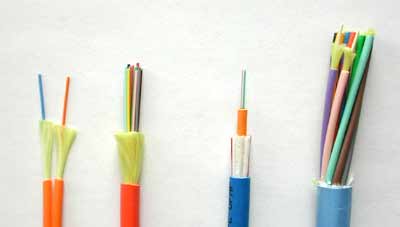
Cables which contain both multimode and singlemode fibers are called ______________. A. Mixed cables
Your Name, CFOT® - It pays to advertise! The FOA encourages CFOTs to use the logo on their business cards, letterhead, truck or van, etc. and provides logo files on this site for that purpose. But we are also asked about how to use the CFOT or CFOS certifications. Easy, you can refer to yourself as "Your Name, CFOT" or "Your Name, CFOS/T" for example. Feel free to use the logo and designations to promote your achievements and professionalism! |
|
Remember To Renew Your Certification ! Remember
to renew your FOA certification. All current CFOTs have a ID Card with
their certification data and we keep a database of current CFOTs to
answer inquiries regarding your qualifications if needed. You must be a
current FOA member and CFOT to participate in our online
database of installers, contractors, technicians and consultants.
If you forgot to renew, use the online application
form to renew NOW! You can now renew your FOA certification online - and get an extra month free. Details here. |
|
|
The correct answer is "B" Cables which contain both multimode and singlemode fibers are called ______________. A. Mixed cables See the FOA Reference Guide for more info. (C)1999-2010, The Fiber Optic Association, Inc. |